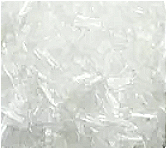| "Descrizione" by Ark90 (12432 pt) | 2023-Mar-22 17:03 |
Review Consensus: 10 Rating: 10 Number of users: 1
| Evaluation | N. Experts | Evaluation | N. Experts |
|---|---|---|---|
| 1 | 6 | ||
| 2 | 7 | ||
| 3 | 8 | ||
| 4 | 9 | ||
| 5 | 10 |
E621 is the Monosodium glutamate also called MSG, the sodium salt of glutamic acid.(alpha-amino acid), is obtained from plants by an industrial process consisting of different steps: extraction, filtration, concentration, drying, crushing, mixing, sieving.
It appears in the form of a white crystalline powder.

Amino acids play a key metabolic function in the human body and are constituents of proteins. Amino acids together with their salts are used in cosmetics as conditioning agents for both hair and skin (e.g. as moisturisers and other similar functions). Moisturisers are different in nature: the best are the natural ones that exploit the mechanism of integration between the ingredient and the skin by moisturising the horny hydrolipid film, i.e. the thin protective layer that covers the epidermis protecting it from harmful external microbes, keeping the skin moisturised and supple and its pH or acidity value between 4 and 6. Then there are the occlusive moisturisers, usually derived from petroleum (Paraffinum, Paraffinum liquidum and others), but also triglycerides, lanolin oil, natural or synthetic waxes, fatty acid esters and others that create an artificial occlusive layer on the stratum corneum of the skin with the advantage of accelerating the protective process but with the disadvantage of preventing the skin's natural transpiration.
α-amino acids that have similar physical structures undergo similar changes with regard to solubility in water/ethanol mixtures, and technologies to separate α-amino acids from industrial residues, which may not even be innocuous, are constantly being improved. However, many data on the solubility in water-ethanol and ethanol of some α-amino acids are contradictory or even lacking, and the effects of ethanol on the solubility of amino acids may be different. Overall, the scientific literature considers that α-amino acids do not pose significant problems for human health when taken orally, except in people with certain genetic diseases.
Food safety
Amino acid α generally considered safe, but with daily doses not to be exceeded. Ingredient included in the list of European food additives as E621, flavour enhancer.
Cosmetic safety
Amino acid α generally considered safe when formulated to be non-irritant.
What it is used for and where
Food
It is a food additive with E621 label on the list of European food additives.
MSG is the typical additive that is found in Chinese cuisine and it is added with the function of making foods tastier or flavor enhancer.

Monosodium glutamate (MSG, C5H8NO4Na) is the sodium salt of glutamic acid. Encoded E621, it is a food additive from a group of flavor enhancers, used in a wide range of foods, such as soups, sauces, mixed condiments, chips, meat products, and puddings. MSG is a natural neurotransmitter in the brain. In humans, the daily intake of free glutamate is greater than 1 g in different forms and the average daily intake of total glutamate is 10 g. High daily intake of MSG results in accumulation and rise of glutamic acid in the blood. The protein-bound glutamate become free only after it goes to the small intestine, hence protein-bound glutamate has no such effect of enhancing the taste of food at this level. Recent evidence suggests that the taste and palatability of MSG are mediated through specific glutamate receptors present in the stomach and intestine . Several studies highlighted the deleterious effects of MSG on many organs when consumed daily. The objective of the current study was to explore the neuroprotective effects of ginger and propolis against MSG-induced neuropathological and toxicological changes. This effect was evident by neurotransmitter and electrochemical assessment in addition to evaluating the oxidative stress markers and antioxidant activity of both treatments in vitro and in vivo in comparison to a standard antioxidant (1).
Cosmetics
Humectant, moisturising.
Safety
An excessive glutamate level can result in excitotoxic damage and death of central nervous system cells, and is involved in the pathogenesis of many central nervous system diseases. It may also be related to a failure of the blood-spinal cord barrier. This study was aimed at examining the effects of extended administration of monosodium glutamate on the BSCB and spinal cord cells in adult male Wistar rats (2).
A single intake of Monosodium glutamate (MSG) may cause headache and increased muscle sensitivity. MSG induced mechanical sensitization in masseter muscle and adverse effects such as headache and short-lasting blood pressure elevation for which tolerance did not develop over 5 days of MSG intake (3).
The intake of foods with high amounts of MSG can affect human health and create neurotoxicity, hepatotoxicity, obesity and diabetes. Some herbs such as Calendula officinalis, Curcuma longa, green tea, Ginkgo bilobae and vitamins have been suggested as remedies (4).
The most relevant studies on this ingredient have been selected with a summary of their contents:
Caratteristiche tipiche del prodotto commerciale Monosodium Glutamate
| Appearance | White crystalline powder |
| pH | 6.9 |
| Boiling Point | 333.8ºC at 760 mmHg |
| Melting Point | 232°C |
| Flash Point | 155.7ºC |
| Refraction Index | 25° (C=10, 2mol/L HCl) |
| Vapor Pressure | 2.55E-05mmHg at 25°C |
| Water Solubility | >=10 g/100 mL at 20ºC |
| PSA | 103.45000 |
| Loss on Drying | ≤0.3% |
| NaCl | 1.3 |
| Particle size | 30-40-60-80-100 mesh |
| Transmittance | 99 |
| Specific rotation | +25° |
| Sulfate | <0,005% |
| Iron | <5 mg/kg |
| Arsenic | <0.5% |
| Pyrrolidone | ≤0.2% |
 |  |
 |  |
- Molecular Formula C5H8NNaO4 C5H10NNaO5 C5H8NNaO4 · xH2O
- Molecular Weight 169.11109
- Exact Mass 169.035110
- CAS 142-47-2, 6106-04-3
- UNII C3C196L9FG
- EC Number 205-538-1
- DSSTox Substance ID
- IUPAC sodium;(2S)-2-amino-5-hydroxy-5-oxopentanoate
- InChl=1S/C5H9NO4.Na/c6-3(5(9)10)1-2-4(7)8;/h3H,1-2,6H2,(H,7,8)(H,9,10);/q;+1/p-1/t3-;/m0./s1
- InChl Key LPUQAYUQRXPFSQ-DFWYDOINSA-M
- SMILES C(CC(=O)O)C(C(=O)[O-])N.[Na+]
- MDL number MFCD00013074
- PubChem Substance ID 24895069
- RTECS MA1500000
- NCI C82289
- FEMA 2756
- RXCUI 1311588
- NACRES NA.32
- SCHEMBL16336
Synonyms:
- Monosodium glutamate
- L-Glutamic acid monosodium salt hydrate
- MSG
- monosodium L-glutamate
- sodium glutamate
- sodium L-glutamate
References________________________________________________________________________
(1) Hussein UK, Hassan NEY, Elhalwagy MEA, Zaki AR, Abubakr HO, Nagulapalli Venkata KC, Jang KY, Bishayee A. Ginger and Propolis Exert Neuroprotective Effects against Monosodium Glutamate-Induced Neurotoxicity in Rats. Molecules. 2017 Nov 8;22(11). pii: E1928. doi: 10.3390/molecules22111928.
(2) Sulejczak D, Taraszewska A, Chrapusta SJ, Dziewulska D, Nakielski P, Rafałowska J. Nanofiber mat spinal cord dressing-released glutamate impairs blood-spinal cord barrier. Folia Neuropathol. 2016;54(4):392-404. doi: 10.5114/fn.2016.64818.
(3) Shimada A, Cairns BE, Vad N, Ulriksen K, Pedersen AM, Svensson P, Baad-Hansen L. Headache and mechanical sensitization of human pericranial muscles after repeated intake of monosodium glutamate (MSG). J Headache Pain. 2013 Jan 24;14:2. doi: 10.1186/1129-2377-14-2.
(6) Hajihasani MM, Soheili V, Zirak MR, Sahebkar A, Shakeri A. Natural products as safeguards against monosodium glutamate-induced toxicity. Iran J Basic Med Sci. 2020 Apr;23(4):416-430. doi: 10.22038/IJBMS.2020.43060.10123.
| Evaluate |

